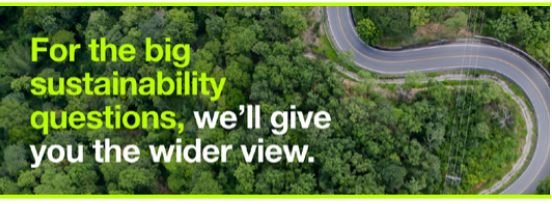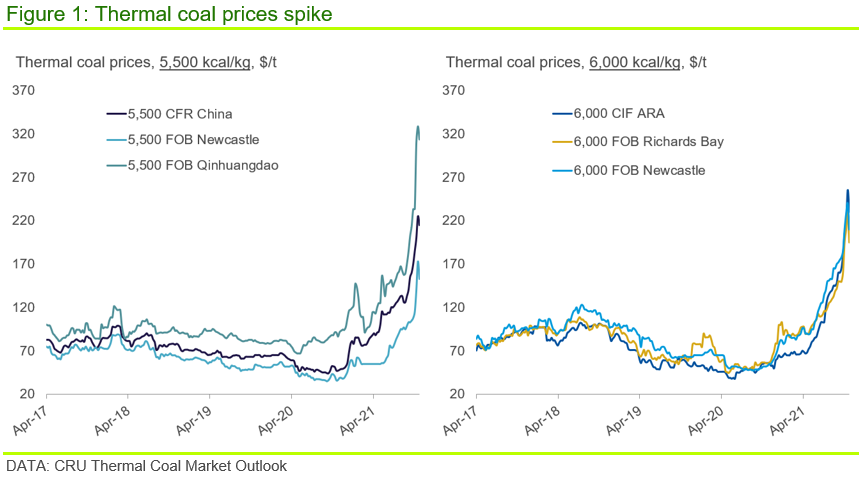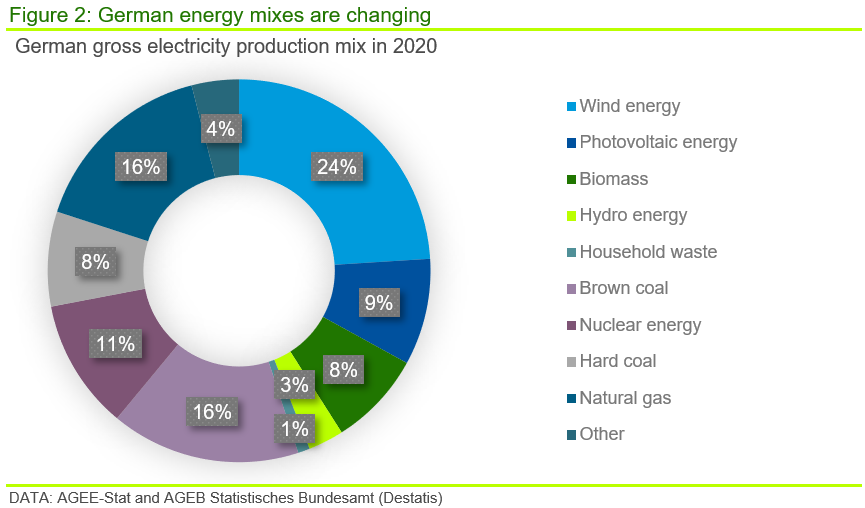Ahead of the crucial COP26 negotiations, governments will be examining diversified energy mixes. Ongoing renewable energy intermittency issues in European power markets could hamper decarbonisation efforts. Balancing fossil fuel use, nuclear energy and renewables, while avoiding energy shortages, extreme price hikes and ensuring rapid decarbonisation will be challenging. Without clear much-needed comprehensive roadmaps, decarbonisation is even more difficult. Businesses may need to prepare for a longer period of uncertainty.

Ongoing renewable energy intermittency issues in European power markets could further challenge decarbonisation efforts. Europe is experiencing soaring energy prices due to a combination of tight gas supply, strong demand and a period with little sunshine and wind. In the German energy sector, this phenomenon is called ‘Dunkelflaute’, a result of the phasing out of nuclear power and a high renewables penetration.
Germany is a prime example of a progressive economy where renewables have already achieved high diffusion. During 2020, wind and solar provided 37.5% of the German net electricity generation. However, during the first three quarters of 2021, that number fell to just 30%, according to data from BDEW (German Association of Energy and Water Industries), with the use of thermal generation increasing. Officials say weather is partly to blame. However, the current energy squeeze could also help spur the transition, if prolonged high energy prices raise the cost of traditional technology, increasing the competitiveness of low carbon alternatives.

Ahead of the crucial COP26 negotiations, governments in the developed world will be considering their strategies for a rapid and sustainable decarbonisation – as provisioned by UN Sustainable Development Goal #7: Affordable and Clean Energy. Governments will be examining diversified energy mixes, more interconnectors across systems and the need for overcapacity to ensure supply. However, there is the risk that current intermittency concerns could cause some governments to delay implementation of these strategies.
According to the European Environment Agency, over 60% of the EU’s emissions derive from energy production, industry use, residential and commercial sectors. Given the drastic renewable energy cost decline over the past decade, these technologies are providing significant decarbonisation opportunities. However, the reduction of technology costs has slowed and without proper subsidies or carbon pricing the pace of their deployment may stagnate. They also have one crucial shortcoming compared to traditional energy sources: we cannot control them.
Despite the technologies’ recent development, intermittency coupled with the lack of efficient energy storage poses a threat to energy security. Even in countries such as Germany, where solar and wind account for around a third of the energy mix, thermal generation still provides a considerable share of baseload.

Profitability of decentralised renewable sources is geographically restricted – some areas simply do not get enough wind or sunlight to enable economic deployment at scale. For example, while Spain has considerable wind and solar resources, Belarus is unlikely to be able to cover their energy needs by simply relying on wind and solar. To overcome local shortages and to maximise resource efficiency, interconnectors are likely to play a crucial role in the future energy systems to ensure energy security. This could create national energy security issues, but a truly effective captive renewables capacity could delink a country from global energy markets, enabling some degree of energy autonomy.
Clear and consistent roadmaps are needed
Intermittency-induced uncertainty around the future of energy supply makes decarbonisation planning challenging. In the era of net zero commitments, corporations will have to navigate changing policy frameworks, while endeavouring to make the best business decisions they can. Many governments have been quick to announce their climate commitments, but the lack of clear pathways and policies, and the potential for changes in direction, is leaving businesses in the dark on how best to adjust.
Roadmaps are needed to minimise uncertainty and to guide firms through decarbonisation. There are risks rooted in the nature of some sustainable solutions, which can have high capital costs and long construction periods. Businesses need time to plan and finance for adjustment.
To invest, or not to invest, that is the question
Factories and sites require maintenance and upgrades, firms need to make decisions whether to maintain the existing infrastructure or invest in an upgrade that complies with changing or new potential regulation. However, path-dependency is a major risk associated with large investments. For example, decarbonising technologies have large upfront costs that need to be paid for and policy support is needed to encourage companies to make these sorts of decisions unilaterally. In the absence of a clear regulator pathway, businesses are often left with three options:
- Maintain the current infrastructure – but there are risks new regulations could mean sites become obsolete or carbon pricing makes them unprofitable.
- Invest in new technology – but there are risks costs could decrease rapidly, other technologies might be developed or subsidies could be made available in the future.
- Postpone maintenance – but accept decreasing efficiency associated with aging assets.
Major infrastructure expenditure can lock corporations into a fixed path. Clarity is needed before costly investments are made. Companies are facing mounting social pressure to decarbonise by switching to renewable energy sources but, until intermittency issues are fixed, some may consider relying solely on renewables a risk.
Commitment issues
On the macro level, the roll out of renewables needs to be faster if the world is going to get even close to the Paris Agreement, but world leaders are unlikely provide us with a much-needed comprehensive roadmap to decarbonisation at COP26. Intermittency problems resulting in serious energy shortages could feed into this delay.
Balancing fossil fuel use, nuclear energy and renewables, while avoiding energy shortages, extreme price hikes and ensuring rapid decarbonisation will be challenging. In the absence of efficient energy storage technology, mass rollout of solar and wind will continue to face intermittency issues. Battery technology will need to improve, which will require considerable R&D investment.
On the micro level, companies face public pressure to decarbonise but investing in a technology prematurely could jeopardise competitiveness. They risk getting locked into an uncertain path. Without clear plans, decarbonisation is even more difficult. Businesses may need to prepare for a longer period of uncertainty.
Find out more about our Sustainability Services.
Our reputation as an independent and impartial authority means you can rely on our data and insights to answer your big sustainability questions.
Tell me more
